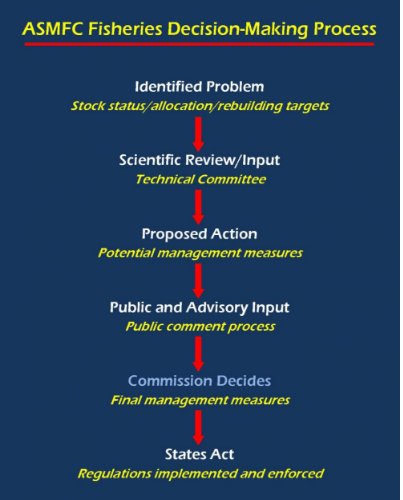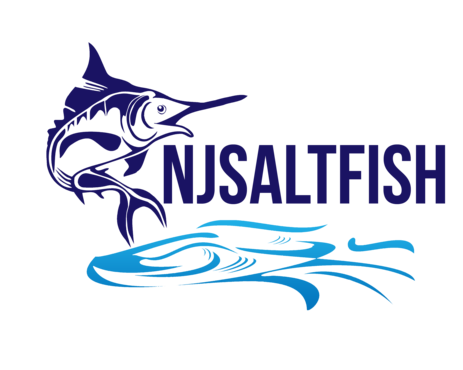How NJ Fishing Regulations are Determined
Fishing regulations have many purposes. The most critical purpose is conservation. As fisherman, we want to continue maintaining the population of marine species for future generations. We also do not want to disturb the equilibrium of the ecosystem. Too high or too low of a population of marine species can wreak havoc on other species as well.
Who Issues Marine Fishing Regulations?
The Atlantic States Marine Fisheries Commission.
The Atlantic States Marine Fisheries Commission manages the majority or marine species on a coast-wide basis with seasons and limits that they determine.
Those regulations must then be approved by the state of New Jersey’s Marine Fisheries Council. The Council usually addresses these issues at their March meeting with the management measures becoming effective in mid- to late April or early May. The Marine Digest is published in May. Regulations remain in effect until changed.
The Atlantic has thousands of Marine Species and each species is unique and has its place in the ecosystem. When regulations are made, it is vital that the unique considerations of each species be heard with an objective point of view, ensuring that no species was treated more important than others.
Because of this, the Atlantic States Marine Fisheries Commission created the Interstate Fisheries Management Program (ISFMP).
To give you a better visual of this flow, check out the picture below, which shows the different levels that make up the commission:

Let’s go over each board:
ISFMP Policy Board: The ISFMP Policy Board is comprised of the Commissioners from the fifteen member states and representatives of the District of Columbia (DC), the Potomac River Fisheries Commission (PRFC), NOAA Fisheries and the U.S. Fish and Wildlife Service. They meets at least bi-annually to establish and monitor the program.
Species Management Boards: These species-specific management boards are composed of Commissioners from the states that have declared an interest in the species’ management program. The management boards consider and approve the development and implementation of fishery management plans (FMPs), including the integration of scientific information, proposed management measures, and considerations for habitat conservation and the management of protected species/fishery interactions. All Commission boards/sections and committee meetings are held in accordance with Robert’s Rules of Order. The species management boards establish and oversee the activities of their respective Plan Review Teams, Plan Development Teams, Technical Committees and Advisory Panels.
Technical Committees: Species technical committees are comprised of representatives from each state, jurisdiction, and federal agency with a declared interest in the fishery. Technical committees are responsible for providing the species management boards the best scientific information available for guidance in the management process.
Advisory Panels: Advisory panel members are citizens who represent a cross-section of commercial and recreational fishing interests and other stakeholders who are concerned about fisheries conservation and management. The Advisory Panel provides the Management Board with advice concerning species’ management activities.
Plan Development and Review Teams: Species Plan Development Team is responsible for preparing all documentation necessary in the development of a FMP, Amendment, or Addendum. Once a management program is adopted by a Species Management Board, the Plan Review Team is responsible for providing annual advice concerning implementation of the management program.
Development of the Management Plan
For a fishery management plan to begin development, a problem must be identified with one of the Commission managed species.
This problem can be identified by a species management board, as a direct result of new scientific research, or through stakeholder input.
Once the problem is identified, the species management board tasks the species plan development team with the creation of a plan proposal. The species plan development team will seek advisement and assistance or input from the technical committee, advisory panel, and Law Enforcement Committee.
The plan is then distributed for public comment and may be held in states with an interest in the fishery. After hearing public comment and concern, the board takes considerations and recommendations of the species technical committee.
Public comment is where we, as fisherman and conservationists, come into play. Let’s learn a bit more about it.
Public Input and the Advisory Panel Process
Since the species plan development team relies on public comment, it must be recognized how important our voices as fisherman play as a role in marine regulations.
We provide input to the commission members, we can attend public information meetings and hearings serving the Advisory Panel.
What is the Advisory Panel?
The Advisory Panel process was born as part of a result of the Commission’s increasing responsibility under the Atlantic Coastal Fisheries Cooperative Management Act.
The Atlantic Coastal Fisheries Act mandates, among other things, that the Commission provide adequate public participation in its fisheries management planning process, including at least four public hearings (for amendments and new plans) and procedures for submission of written comments to the Commission. Today, we have 21 active advisory panels that provide advice to management boards and sections for all of the species managed through the Commission process.
Here is a picture of how the ASMFC works:

HOW TO GET INVOLVED
There are many ways to become involved in the Commission’s fisheries management process. Here are some suggestions:
Attend Commission Meetings
All Commission meetings are open to the public. Interested parties are encouraged to attend to learn more about Commission activities and share their views (click here to learn more about guidelines for public participation at species board meetings). Find out about the Commission’s meetings by subscribing to Fisheries Focus -- the Commission’s monthly newsletter that is available free of charge. You can also learn about upcoming meetings via our Meetings page.
Become an Advisory Panel Member
The Commission has 21 active species advisory panels for diadromous, shellfish and marine fisheries. Contact your state Commissioners if you are interested in becoming a member.
Attend Public Hearings
The fishery management plan development process calls for public meetings and public hearings to solicit public views on proposed management actions. Attend these meetings to learn more and express your views.
Mail, Fax or Email Your Comments
Submitted comments are forwarded to the appropriate management board and/or Commission staff for review and incorporation in the public record. You can email, mail, fax comments to the Commission using the contact information below.
Contacts
Toni Kerns, Director, Interstate Fisheries Management Program
Tina Berger, Director of Communications
Guiding Documents
ASMFC Compact, Rules and Regulations (revised February 2016)
ISFMP Charter (revised February 2016)
Conservation Equivalency: Policy and Technical Guidance Document (October 2016)
Technical Support Group Guidance and Benchmark Stock Assessment Process (February 2016)
Advisory Panel Nomination Form
Atlantic Coastal Fisheries Cooperative Management Act (1993)



